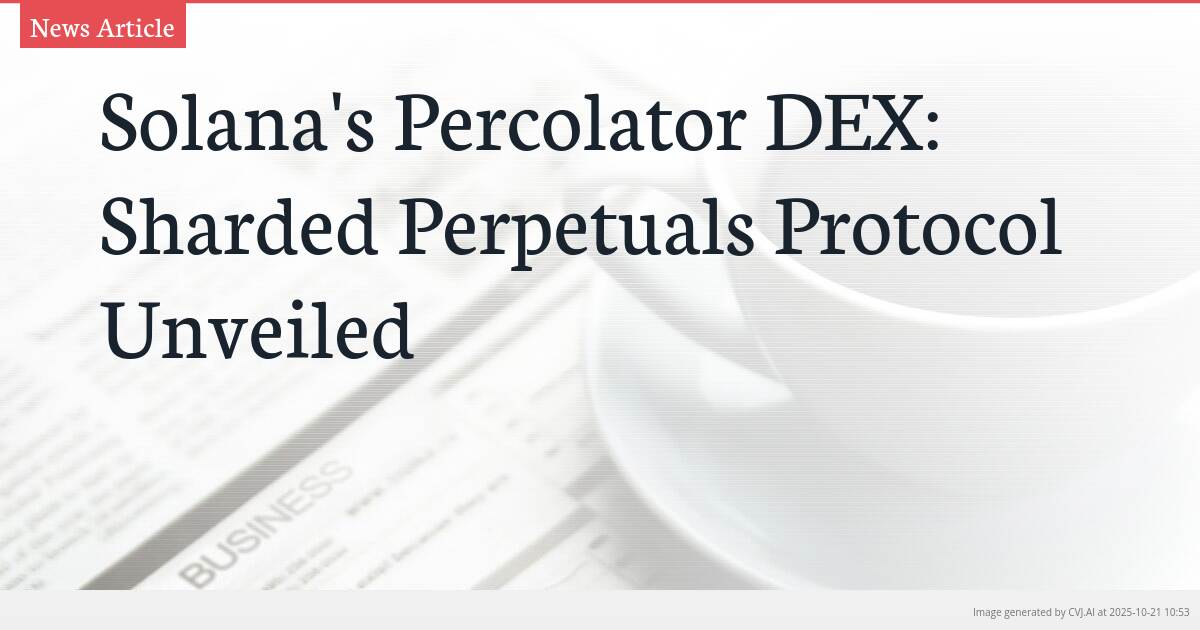Introduction
Solana Labs co-founder Anatoly Yakovenko has unveiled Percolator, a groundbreaking sharded perpetuals protocol built directly on the Solana blockchain that promises to revolutionize decentralized derivatives trading. This new decentralized exchange aims to provide high-speed, self-custodial trading for perpetual futures contracts through an innovative architecture that isolates risk while maintaining atomic execution. With implementation-ready documentation already published on GitHub, Percolator represents Solana’s ambitious entry into the fiercely competitive crypto derivatives market at a time when the platform faces both technical challenges and growing competition from emerging protocols.
Key Points
- Percolator uses a sharded architecture with independent Slab programs for matching and settlement, ensuring problems in one slab don't affect others
- The protocol features completed data structures for order books and memory pools, though liquidation systems are still under development
- Competitor Hyperliquid recently enabled permissionless perpetual contracts through its HIP-3 upgrade, requiring 500,000 HYPE tokens ($18M) to launch new markets
Architectural Innovation: The Router and Slab System
Percolator’s core innovation lies in its two-component architecture consisting of a Router and independent Slab programs. The Router serves as the central nervous system, managing collateral, portfolio margins, and cross-slab routing while ensuring atomic execution across the entire system. Meanwhile, each Slab program functions as an autonomous matching engine overseen by individual liquidity providers, creating what Yakovenko describes as “fully self-contained matching and settlement.” This design fundamentally isolates risk, ensuring that any issues arising within a particular slab cannot affect users who haven’t interacted with it.
Yakovenko emphasized the strategic advantages of this architecture, stating: “This design keeps each LP’s slab fully self-contained and innovable, while the Router guarantees atomic routing, portfolio netting, and capability-scoped safety.” The GitHub repository shows completed data structures for order books and memory pools, indicating significant technical progress. However, development of critical liquidation systems remains ongoing, highlighting the complex challenges inherent in building robust derivatives infrastructure.
Competitive Landscape: Entering a Crowded Derivatives Arena
Percolator enters a derivatives market where competition is intensifying rapidly, particularly from protocols like Hyperliquid (HYPE) that have gained substantial market traction. Hyperliquid recently implemented permissionless, builder-deployed perpetual contracts through its HIP-3 upgrade, requiring users to stake a minimum of 500,000 HYPE tokens—approximately $18 million—to launch their own perpetual markets with independent margin rules. This approach has proven remarkably successful, with Hyperliquid accounting for 35% of all blockchain revenue in July and attracting high-value users away from established platforms including Solana, Ethereum (ETH), and BNB Chain.
Asset manager VanEck recently noted that Hyperliquid’s success stems from its “simple, highly functional product” that effectively retains sophisticated traders. This competitive pressure comes at a challenging time for Solana, with SOL trading at $187.70—representing a 20% decline over both fourteen and thirty-day periods and sitting 35% below its all-time high of $293 reached earlier this year. The timing of Percolator’s development suggests Solana Labs recognizes the strategic importance of capturing derivatives market share to bolster ecosystem growth and token value.
Development Status and Ecosystem Implications
Currently, the Solana Foundation has not disclosed whether Percolator will receive formal ecosystem support or emerge as a community-driven protocol. The code remains under active review on GitHub, with developers involved in the repository indicating the project is “deep in testing.” This suggests a potential launch could be imminent, contingent on finalizing the liquidation and governance components that are crucial for any derivatives platform’s operational safety and long-term viability.
Should Percolator succeed, it would significantly expand Solana’s repertoire of native financial primitives, joining existing decentralized options, lending protocols, and tokenized asset platforms. The project’s sharded architecture represents a technical evolution in how decentralized exchanges can manage risk and scalability simultaneously. While no official launch date has been announced, the implementation-ready documentation and completed core data structures indicate that Solana Labs is positioning Percolator as a serious contender in the rapidly evolving world of decentralized derivatives trading.
📎 Source reference: newsbtc.com

